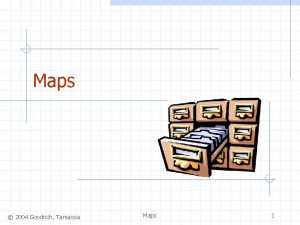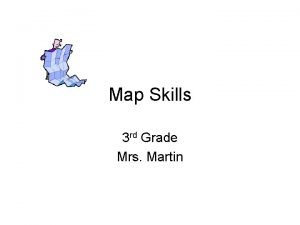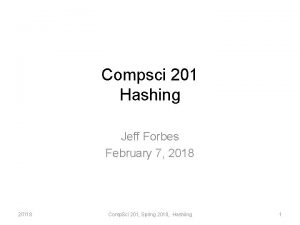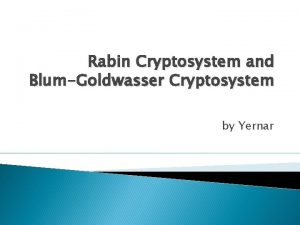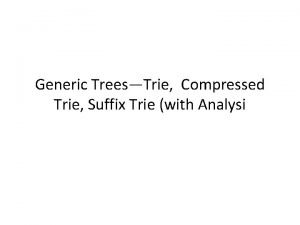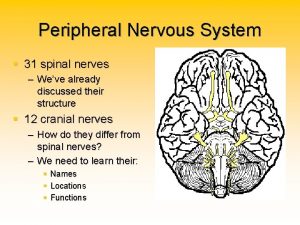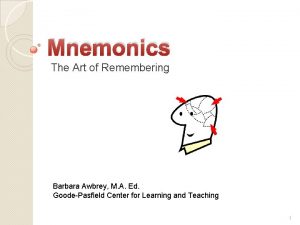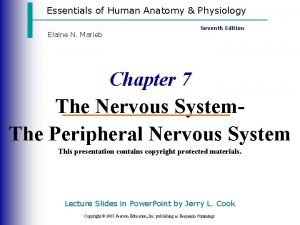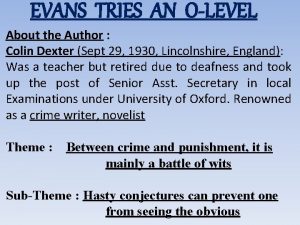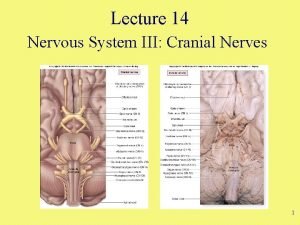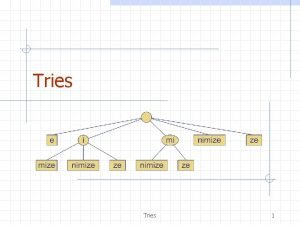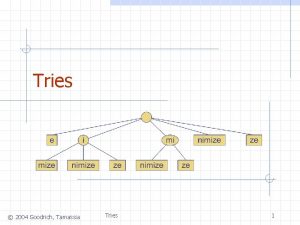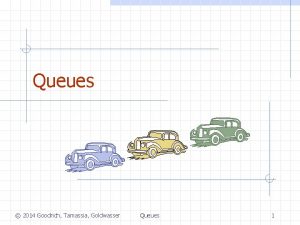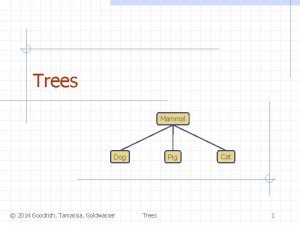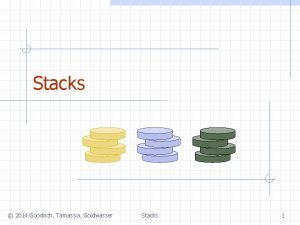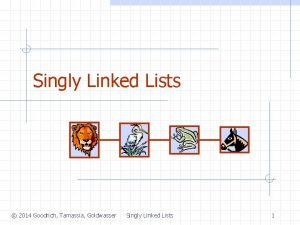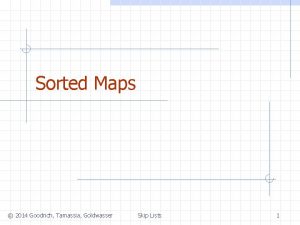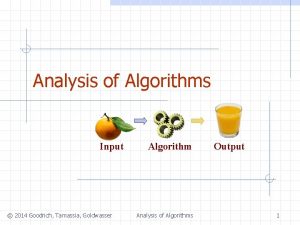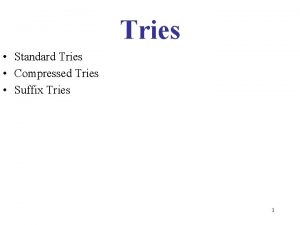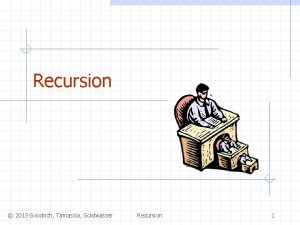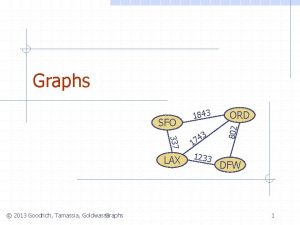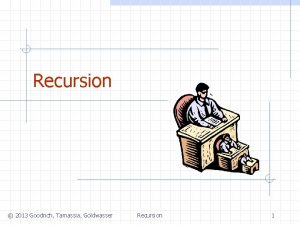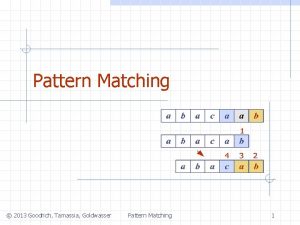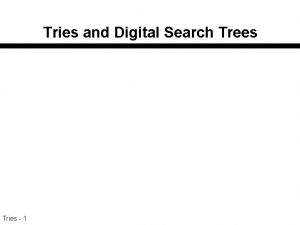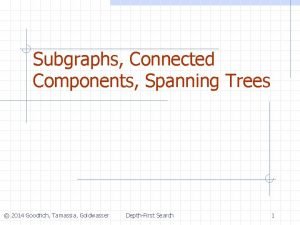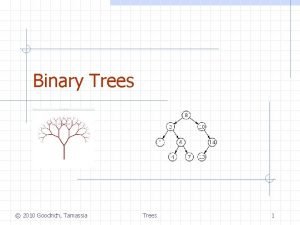Tries 2014 Goodrich Tamassia Goldwasser Tries 1 Motivation




















- Slides: 20

Tries © 2014 Goodrich, Tamassia, Goldwasser Tries 1

Motivation Consider the words of a document/book (e. g. C library functions, Bible, Shakespeare) are frequently searched by many users. How can we design a data structure to speed up the search? © 2014 Goodrich, Tamassia, Goldwasser Tries 2

Preprocessing Strings A trie represents a set of strings n E. g. all the words in a text n supports pattern matching queries in time proportional to the pattern size, ie O(m) Re”trie”val © 2014 Goodrich, Tamassia, Goldwasser Tries 3

Standard Tries The standard trie for a set of strings S is an ordered tree such that: n n n Each node but the root is labeled with a character The children of a node are alphabetically ordered The paths from the external nodes to the root yield the strings of S Example: standard trie for the set of strings S = { bear, bell, bid, bull, buy, sell, stock, stop } © 2014 Goodrich, Tamassia, Goldwasser Tries 4

Analysis of Standard Tries A standard trie uses O(n) space supports searches, insertions and deletions in time O(dm), where: n total size of the strings in S m size of the string parameter of the operation (e. g. , 3 in bid) d size of the alphabet (eg, 26) n © 2014 Goodrich, Tamassia, Goldwasser Tries 5

Word Matching with a Trie insert the words of s the text into trie 0 Each leaf is s associated w/ one 24 particular word leaf stores indices b where associated 47 word begins h (“see” starts at index 0 & 24, leaf 69 for “see” stores those indices) e e a b e a r ? e e a l r l 6 78 s t o c k ! b u l l ? b u y s t o c k ! 25 26 27 28 29 30 31 32 33 34 35 36 37 38 39 40 41 42 43 44 45 46 i d s t o c k ! b i d s t o c k ! 48 49 50 51 52 53 54 55 56 57 58 59 60 61 62 63 64 65 66 67 68 e a r t h e b e l l ? s t o p ! 70 71 72 73 74 75 76 77 78 79 80 81 82 83 84 85 86 87 88 h i a l 1 2 3 4 5 6 7 8 9 10 11 12 13 14 15 16 17 18 19 20 21 22 23 b e s e l d 47, 58 © 2014 Goodrich, Tamassia, Goldwasser u l l s e y 36 a r 69 30 Tries e e 0, 24 t l l 12 o c k 17, 40, 51, 62 p 84 6

Compressed Tries internal nodes of degree at least two obtained from standard trie by compressing chains of nodes with only one child ex. the “i” and “d” in “bid” are “redundant” because they signify the same word © 2014 Goodrich, Tamassia, Goldwasser Tries 7

Compact Representation Compact representation of a compressed trie for an array of strings: n n n Stores at the nodes ranges of indices instead of substrings Uses O(s) space, where s is the number of strings in the array Serves as an auxiliary index structure index. Of. S, start, end © 2014 Goodrich, Tamassia, Goldwasser Tries 8

Suffix Trie The suffix trie of a string X is the compressed trie of all the suffixes of X © 2014 Goodrich, Tamassia, Goldwasser Tries 9

Suffix matching (naturally) suffix = “ize” Is suffix in text? © 2014 Goodrich, Tamassia, Goldwasser Tries 10

Pattern matching pattern = “min” Is pattern in text? © 2014 Goodrich, Tamassia, Goldwasser Tries 11

Frequency of pattern = “mi” How many times “mi” occurs? © 2014 Goodrich, Tamassia, Goldwasser Tries 12

Suffix Trie Add locations of suffix at the leaves 7 2 3 1 © 2014 Goodrich, Tamassia, Goldwasser 5 0 Tries 6 4 13

Locations of a pattern Pattern = “mi” What are the locations of the pattern? 7 2 3 1 © 2014 Goodrich, Tamassia, Goldwasser 5 0 Tries 6 4 14

Locations of a pattern Pattern = “mini” What are the locations of the pattern? 7 2 3 1 © 2014 Goodrich, Tamassia, Goldwasser 5 0 Tries 6 4 15

Compact Representation Each node stores the begin and end indices in the array © 2014 Goodrich, Tamassia, Goldwasser Tries 16

Analysis of Suffix Tries string X of size n from an alphabet of size d n Uses O(n) space n Can be constructed in O(n) time (not discussed) n Supports pattern/suffix matching in X w O(dm) time, where m is the size of the pattern © 2014 Goodrich, Tamassia, Goldwasser Tries 17

Skipping the rest © 2014 Goodrich, Tamassia, Goldwasser Tries 18

Encoding Trie (1) A code is a mapping of each character of an alphabet to a binary code-word A prefix code is a binary code such that no code-word is the prefix of another code-word An encoding trie represents a prefix code n n Each leaf stores a character The code word of a character is given by the path from the root to the leaf storing the character (0 for a left child and 1 for a right child 00 011 10 11 a b c d e © 2014 Goodrich, Tamassia, Goldwasser a Tries d b c e 19

Encoding Trie (2) Given a text string X, we want to find a prefix code for the characters of X that yields a small encoding for X Frequent characters should have short code-words Rare characters should have long code-words n n Example X = abracadabra T 1 encodes X into 29 bits T 2 encodes X into 24 bits n n n T 1 T 2 c d a b r © 2014 Goodrich, Tamassia, Goldwasser a b c Tries r d 20
 Goodrich tamassia
Goodrich tamassia Goodrich tamassia
Goodrich tamassia Laura tamassia
Laura tamassia Map key
Map key Shaffi goldwasser
Shaffi goldwasser Shafi goldwasser
Shafi goldwasser Rabin cryptosystem example
Rabin cryptosystem example Heidi goodrich andrade
Heidi goodrich andrade Afge local 910
Afge local 910 Flood routing example
Flood routing example Reservoir routing example
Reservoir routing example Ali ahmed is a mathematics professor who tries to involve
Ali ahmed is a mathematics professor who tries to involve Standard trie example
Standard trie example Old opie occasionally tries
Old opie occasionally tries Colin dexter the author of evans
Colin dexter the author of evans Explain how scouts treatment of the roly poly
Explain how scouts treatment of the roly poly Old opie occasionally tries
Old opie occasionally tries Motor sensory cranial nerves mnemonic
Motor sensory cranial nerves mnemonic Evans tries an o level author
Evans tries an o level author Old opie cranial nerves
Old opie cranial nerves Standard tries
Standard tries
